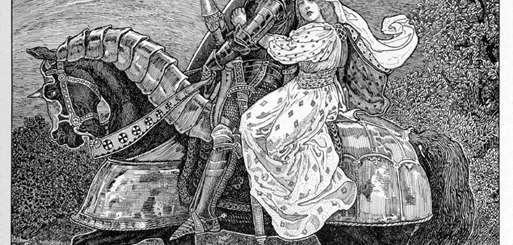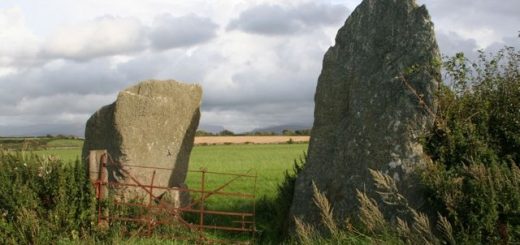The Rudston Monolith
Standing in the Norman churchyard of All Saints Church, the Rudston Monolith is the highest standing stone in Great Britain at 7.6m (25ft) with a 5m circumference and an estimated weight of 40 Tonnes.
An experiment run by William Strickland in the 18th century suggests the stone may extend underground to a similar depth as it high above ground.
 The stone is made from Moor Grit Conglomerate which probably came from Cayton Bay about 10 miles to the north or the Cleveland Hills. The stone which now has a protective lead cap on top of its tip, was probably erected around 1600BC and may have been the reason Rudston got its name. In Old English Rudston implies Rood-stane or Cross-stone.
The stone is made from Moor Grit Conglomerate which probably came from Cayton Bay about 10 miles to the north or the Cleveland Hills. The stone which now has a protective lead cap on top of its tip, was probably erected around 1600BC and may have been the reason Rudston got its name. In Old English Rudston implies Rood-stane or Cross-stone.
It certainly pre-dates the church that was built next to it, but this could indicate the religious importance placed on the stone. There is a fairly recent theory that there may be fossilised dinosaur footprints on one side of the stone.
The Rudston Monolith is associated with several legends. In one it was thrown by the Devil at the church but his aim was of as usual and it landed in the churchyard. This is a common legend attached to many churches throughout Britain. It is also said to have fell from the sky to kill people who were going to desecrate the churchyard.




Re: The Rudston Monolith
The following is extracted from ‘County Folk-Lore Volume VI – Examples Of Printed Folk-Lore Concerning The East Riding Of Yorkshire (1911)’ Edited by Eliza Glutch.
Rudston. Celebrated for the Obelisk in its churchyard. It is composed of one immensely large stone ; it is thought by some to have given the name to the parish. Its height is 29 ft. 4 in., and it has been traced 16 ft. into the ground without its bottom being reached ; it is 2 ft. 3 in. in thickness, and its sides are concave. … Its weight is supposed to be about 46 tons, and its distance [is] nearly 40 miles from the nearest quarry. — Warne, p. 72.
In the East Riding of Yorkshire, some eight miles from Bridlington, stands the Wold village of Rudston, celebrated for the tall stone in its churchyard. This stone is nearly 30 ft. high, and its estimated weight is 25 tons. It penetrates the earth about 20 ft. The monolith and church are mentioned in Doomsday Book, and many are the opinions as to the origin of the former, which is shrouded in mystery. The local tradition is that it fell from the clouds, killing and burying certain desecrators of the churchyard.
Tradition says the devil threw [it] to destroy church and builders. Fortunately he missed his aim, but there the marble stands, a monument of miscarried malignity. Nicholson (2), p. 62.
There is a report current that it was hewn out of a quarry at Whitby ; but I deem it far more probable that it is one of those glacial deposits which lie scattered through the country. [The author goes on to describe how it might have been conveyed by men and rollers.] — Royston, p. 62.
An old woman in the village informed the author that she could remember the remains of a similar block of stone, which was situated some yards to the east of the present obelisk. Allen, vol. ii. p. 326, footnote.
The late Archdeacon Wilberforce, who was at that time Rector of Burton Agnes, had come over to make an inspection of the Church, when he met an old parishioner in the Church yard. The Archdeacon said to him, "Well! my good man, can you tell me anything about this wonderful stone?" “Na, I can’t say as how I can," was the answer. "Why! you’ve lived here a great many years, and surely you must know something about it," said the Archdeacon. "Na, I doint," was the laconic reply. "Well! then if you don’t know anything about it and can’t tell me anything about it," said the Archdeacon, "you can tell me what they say about it." "Whoy! yaas, I can tell you what they say about it," was the information derived this time. "Come then, my friend, let me hear what they do say about it," said the Archdeacon. "Well!" replied our Rudstonian friend, "they says it was put up here to commemorate a great vict’ry ‘tween Danes and Roman Cathlicks." Royston, p. 66.
In A.D. 1865 a relation of Mr. Huffam of Hessle, a friend of ours, met a Danish gentleman staying at Scarborough, who inquired of him where he should find a place called Rudston on the Yorkshire Wolds, where he wished to see a "Beauta Stone," [1] mentioned in an ancient Saga still preserved at Copenhagen, which Saga states, as he informed the gentleman, that a Viking called "Rudd" died of malaria whilst in England and was buried on the Wolds; and that afterwards his Beauta Stone was sent over from Denmark, and erected at his place of sepulchre [sic] which ever after was called Rudston, having before that borne another name. The Danish gentleman, having learned from his friend the locahty of Rudston, was at some expense to go and verify the narrative in the said Saga. There is at Rudston a tradition that it once bore another name, "Seaton" we believe; but no one has any tradition about the stone there. — ^Thompson, p. 191.
In a letter received from Mr. Llewellynn Jewitt, F.S.A., the editor of the Reliquary and a Fellow of the Royal Society of Northern Antiquities of Copenhagen, he says, "I am extremely sorry to say that I know of no Saga containing the matter alluded to in the extract." — Royston, p. 71, footnote.
Rudston. The Rudston monolith is called the grandmother of the church. — Wood Rees, p. 14.